#Shakkyo
Text

Shakkyo - Noh
Paul Binnie - 1997
This is the only print of Noh in this group of Kabuki woodblocks and is done in a "Sosaku-hanga" or creative print style identified by "drawing" straight onto the block with a chisel.
"Shakkyo" means a stone bridge, and refers to the bridge to heaven guarded by Shishi, or mythological, lions.
The mask, shishiguchi, is gilded while the wig is red and made of yaks' hair.
#art#japan#japan art#noh#kabuki#kabuki thetare#asian art#japanese culture#japanese art#ukiyoe#japanese theatre#woodblock#woodblock print#ukiyo e#paul binnie
33 notes
·
View notes
Note
I was watching two different videos with the same dance, but one says the dance is Shakkyo, the other video says the same dance is Ishibashi. I cannot find the videos online. It's danced by two geiko, each having a fan and a stick of peonies - one red and the other one white. What's the real name of the dance, please?
That sounds like Shakkyo ^^
11 notes
·
View notes
Photo
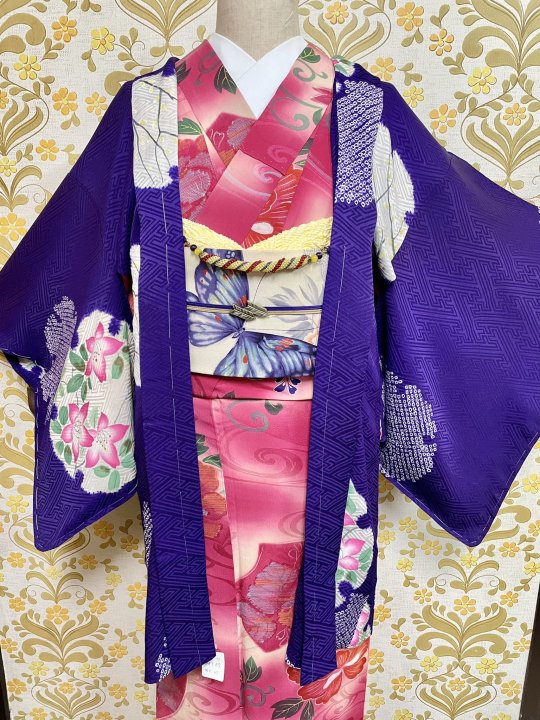
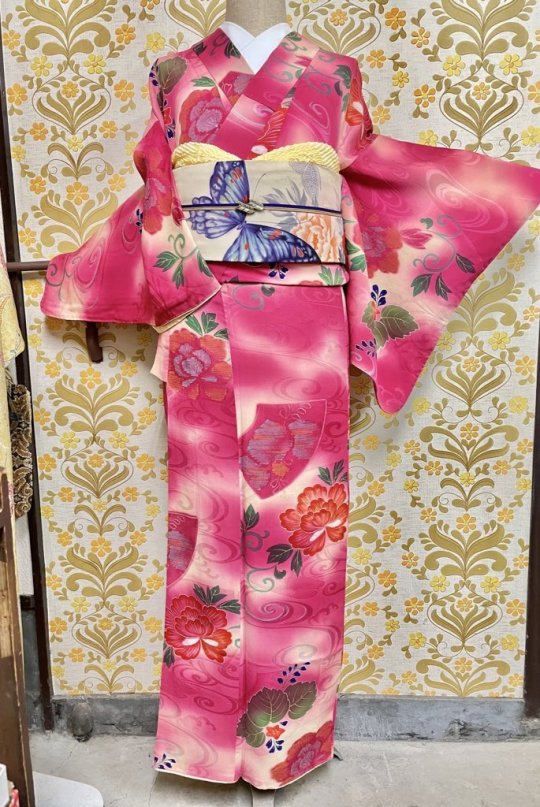
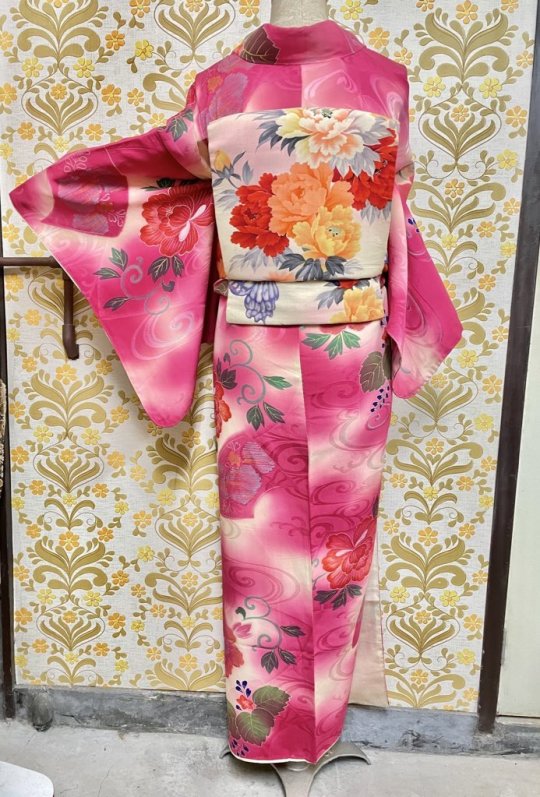

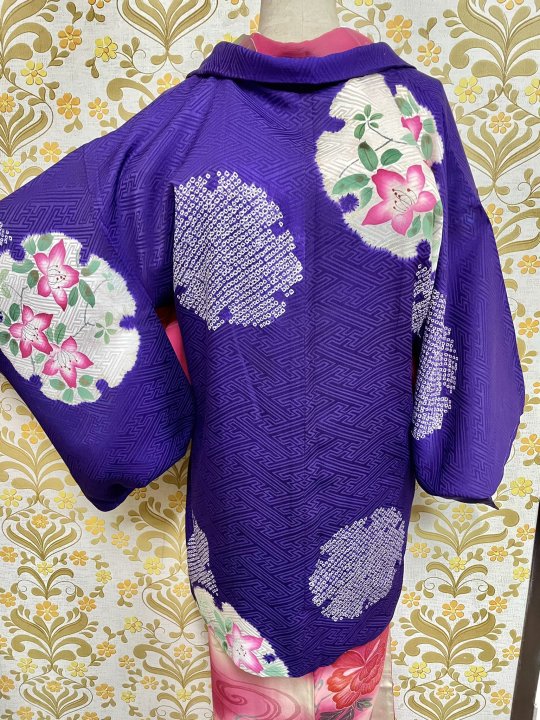
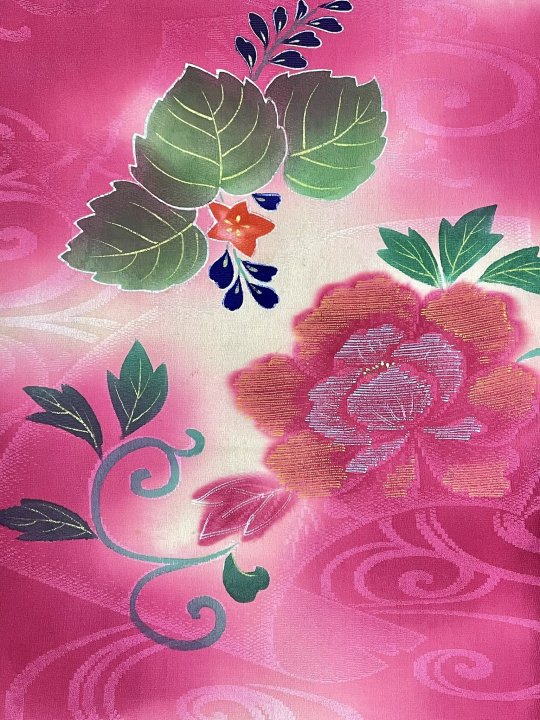
Antique kimono outfit, featuring a lively magenta kimono with botan (peony), ryuusui (running water), and kiri (paulownia), paired with a romantic blue butterfly and botan obi. I love how the purple haori (with tsutsuji/azalea in yukiwa/snowflakes) picks the blue tones of that glorious butterfly!
Botan+ryuusui+tsutsuji are patterns usually worn during April, while kiri is an auspicious all-seasons one. I love how the obi pairs botan+butterfly, it’s maybe a nod to the Shakkyo (the stone bridge) noh play ^^
#japan#fashion#kimono#obi#botan#ryuusui#kiri#butterfly#tsutsuji#peony#stream#running water#paulownia#azalea#shakkyo#noh play#着物#帯
109 notes
·
View notes
Photo

Kimono, Japan ca. 1860-1880 ℹ Outer #kimono (uchikake) depicting a figure of a bridge across a river gorge, with shishi (mythical lions) and two figures below among peonies. Satin silk with appliqué and embroidery. Lining of polychrome figured silk and red cotton. ℹ The motif on this extremely exuberant outer kimono ( #uchikake ) is a theatrical one which relates to the Chinese legend of #Shakkyo (Stone Bridge). ℹ This refers to a bridge over a steep gorge near the summit of Mount Seiryo which is reputed to lead to the #Buddhist paradise and which is guarded by shishi (mythical lions). ℹ The #kabuki play adapted from this story culminates in a dramatic shakkyomono, or lion dance. The figure on the bridge is a kabuki actor who embodies the spirit of the shishi, while below actual shishi are depicted with other figures surrounded by peonies. ℹ It is possible, therefore, that the uchikake was worn for a kabuki theatre performance. Costumes worn on stage certainly needed to be flamboyant and eye-catching, but the motifs were not normally so literal. ℹ It is more likely, therefore, that this garment belonged instead to a high-ranking #courtesan ℹ The three figures, shishi and peonies are composed of satin and crepe silk, dyed in bright colours, which have been applied to the black ground and then outlined with couched gold-wrapped thread. ℹ The bridge, clouds, water, leaves and other elements are also in couched gold embroidery. The design is padded in places to add extra three-dimensionality, while the eyes of the shishi are of glass as are those of the main figure on the bridge who also has actual hair, from an animal, and buttons of metal. #history #museumcollection #antiquetextile #instamuseum #museumoninstagram #antiquesilk #historicaldress #costumehistory #fashion #historicalfashion #historicalclothing #dresshistory #fashionhistory #historicalcostume #fashionhistorian #19thcentury #19thcenturyfashion #japan #japanese #japanesekimono #japanesecostume Source: The MET https://www.instagram.com/p/B2ixIgcgHpu/?igshid=q0t64nps5ig5
#kimono#uchikake#shakkyo#buddhist#kabuki#courtesan#history#museumcollection#antiquetextile#instamuseum#museumoninstagram#antiquesilk#historicaldress#costumehistory#fashion#historicalfashion#historicalclothing#dresshistory#fashionhistory#historicalcostume#fashionhistorian#19thcentury#19thcenturyfashion#japan#japanese#japanesekimono#japanesecostume
0 notes
Photo

The Actor Segawa Kikunojo II in Shakkyo Dance in the Play Soga Moyo Aigo no Wakamatsu, Performed at the Nakamura Theater in the Second Month, 1769, Ippitsusai Buncho, 1764, Art Institute of Chicago: Asian Art
Clarence Buckingham Collection
Size: 31.4 x 14.3 cm (12 3/8 x 5 5/8 in.)
Medium: Color woodblock print; hosoban
https://www.artic.edu/artworks/22354/
12 notes
·
View notes
Photo
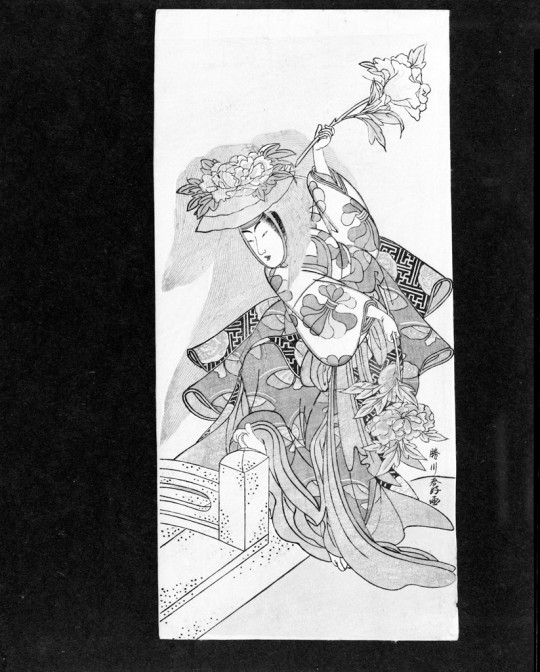
Actor Segawa Kikunojō 3rd as a Shakkyo Dancer, Katsukawa Shunkō, Edo period, late 18th to early 19th century, Harvard Art Museums: Prints
Harvard Art Museums/Arthur M. Sackler Museum, Philip Hofer Fund for the Purchase of Asian Art
Size: Paper: H. 31.7 cm x W. 15.1 cm (12 1/2 x 5 15/16 in.)
Medium: Ukiyo-e woodblock print in "hosoban" format; ink, color and gauffrage ("blind" printing) on paper, with printed signature reading "Katsukawa Shunkō ga"
https://www.harvardartmuseums.org/collections/object/200750
5 notes
·
View notes
Photo
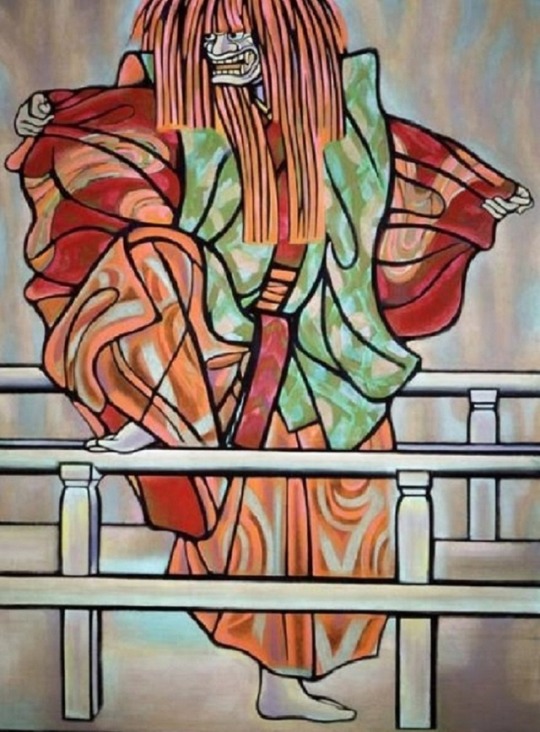
Meiji Hashimoto 橋本明治 - “Shakkyo”, Noh Play (color on paper, framed,1961)
23 notes
·
View notes
Video
youtube
日本博特別公演「日本の音と声と舞」/Japan Cultural Expo Special Performance “Japanese Music, Song and Dance” ~ 日テレ公式チャンネル 「日本博」では,総合テーマ「日本人と自然」の下に,「美術・文化財」「舞台芸術」「メディア芸術」「生活文化・文芸・音楽」「食文化・自然」「デザイン・ファッション」「共生社会・多文化共生」「被災地復興」等の各分野にわたり,縄文時代から現代まで続く「日本の美」を国内外へ発信し,次世代に伝えることで更なる未来の創生を目指します。 特別公演の第一部では,広報大使の黒柳徹子さんのメッセージに始まり,アイヌ古式舞踊,ミュージカル『刀剣乱舞』を,続く第二部では,「月雪花にあそぶ」と題した歌舞伎,能,文楽,雅楽,日本舞踊,合唱など多くの舞台芸術をお楽しみください。 日本博HP :https://ift.tt/3hNVnGj 公式twitter:https://twitter.com/JPNCulturalExpo ◆会場/東京国立博物館 平成館 ◆2020年3月14日(土)収録 ◆主 催:文化庁 独立行政法人日本芸術文化振興会 特別協力:東京国立博物館 第一部 ◆日本博広報大使メッセージ/黒柳徹子 ◆アイヌ古式舞踊 「鶴の踊り」/アイヌ民族文化財団 ◆2.5次元ミュージカル ミュージカル『刀剣乱舞』/刀剣男士 (髭切/膝丸) ※日本博広報大使メッセージおよびアイヌ古式舞踊は別途収録した映像での出演です 第二部 月雪花(つき ゆき はな)にあそぶ ◆笙(しょう)「盤渉調調子(ばんしきちょうちょうし)」 宮田まゆみ ○奈良時代以前に大陸から伝わった楽器 ○冬にふさわしい調子とされる盤渉調の旋律を奏でる ◆日本舞踊「鷺娘(さぎむすめ)」 鷺の精 尾上紫紫(ゆかり) ○雪の中に降り立った一羽の鷺の姿を借りて恋に悩む娘心を舞踊化 ◆胡弓「雪(ゆき)」 川瀬露秋 ○ヴァイオリンやチェロのように弦を擦って演奏する和楽器 ○「雪」は,来ぬ人を待つ心情を表現した名曲で,その中の胡弓のパート等を演奏 ◆声明「散華(さんげ)」 天台聲明 七聲會 ○声明(しょうみょう)は仏教儀式で唱えられる声楽 ○蓮の花をかたどった紙=花を撒いて場内を清める 今回は東博のシンボル「ゆりの木」の葉をモチーフにしたものを使用 ◆能「羽衣(はごろも)」 シテ/天人 観世清和 ○月の世界から舞い降りてきた天女が舞う ○謡に笛,小鼓,大鼓,太鼓の四拍子の演奏と,格調高く清々しい舞に注目 ◆尺八「寒月(かんげつ)」 ジョン・海山・ネプチューン ○リードのない竹製の縦笛で,海外でも普及している和楽器 ○演奏曲は,冬の寒月の叙景曲 冴え渡る月を思い浮かべてほしい ◆文楽「団子売(だんごうり)」 人形 杵造/桐竹勘十郎 お臼/吉田勘彌 ○太夫・三味線の演奏に乗り、三人で一体の人形を操る世界でも類を見ない人形芝居 ○仲の良い夫婦が月を見上げ,楽しく団子をつく様子をほほえましく描く ◆篠笛「月(つき)」 福原徹彦 ○細い篠竹で作られた横笛 ○柔らかな音色が郷愁を誘う ◆琉球古典音楽「伊集早作田節(いじゅはいちくてんぶし)」 歌・三線 新垣俊道 喜納吏一/笛 大城建大郎/太鼓 久志大樹 ○「伊集早作田節」 は,蘭の花に寄せて心情を謳う ○三線は,沖縄の豊かな自然・文化を感じることができる楽器 ◆合唱「越天楽(えてんらく)~花(はな)」 指揮 三澤洋史/新国立劇場合唱団 ○雅楽の古典曲で最も有名な「越天楽」に,滝廉太郎の名曲 「花」を合わせた今回のための特別アレンジ ○古くて新しい合唱曲を和の装いで披露する ◆歌舞伎「石橋(しゃっきょう)」 獅子の精 尾上菊之助 ○清涼山の橋に現れる獅子の精が咲き乱れる牡丹に戯れる姿を描く「石橋」 ○長い毛を振り,勇壮に踊る姿は圧巻 力強く華やかに締めくくる ※各演目,一部分のみの上演です ◆スタッフ・関係者 構成・演出/大和田文雄(独立行政法人日本芸術文化振興会(国立劇場)理事) 空間演出/谷川じゅんじ(JTQ inc.) 映像演出/WOW 樹木演出 小松宏誠 音楽監修・作曲/新内多賀太夫 振付(石橋)/尾上菊之丞 技術監督/横沢紅太郎 美術・照明・音響・舞台・舞台監督/国立劇場 制作 独立行政法人日本芸術文化振興会/国立劇場・国立能楽堂・国立劇場おきなわ・ 新国立劇場・日本博事務局 Japan Cultural Expo Special Performance“Japanese Music, Song and Dance” ◇Tokyo National Museum Heiseikan building ◇Recorded on March 14(Sat), 2020 ◇Organized by : Agency for Cultural Affairs Japan Arts Council Special Cooperation by : Tokyo National Museum PartⅠ ◇Remarks by Japan Cultural Expo Official Ambassador KUROYANAGI Tetsuko ◇Ainu Ancient Ceremonial Dance “The Sarorun Rimse (Crane Dance)” The Foundation for Ainu Culture ◇2.5-Dimensinonal Musical Touken Ranbu:The Musical Touken Danshi [Higekiri/Hizamaru] PartⅡ Celebrating the Natural Beauties of Japan ◇Sho“ Banshikicho Chosi” ◇Traditional Japanese Dance“ Sagi Musume” ◇Kokyu “Yuki” ◇Shomyo (Japanese Buddist Chant)“Sange” ◇Noh “Hagoromo” ◇Shakuhachi“Kangetsu” ◇Bunraku“Dango Uri” ◇Shinobue “Tsuki” ◇Sanshin music“ Iju Haichikuten Bushi” ◇Chorus “Etenraku~Hana” ◇Kabuki “Shakkyo” Fore more information: https://ift.tt/312z9dM #日本博 #文化庁 #舞台 From Things I'm interested in https://ift.tt/2CqPtuL
0 notes
Photo
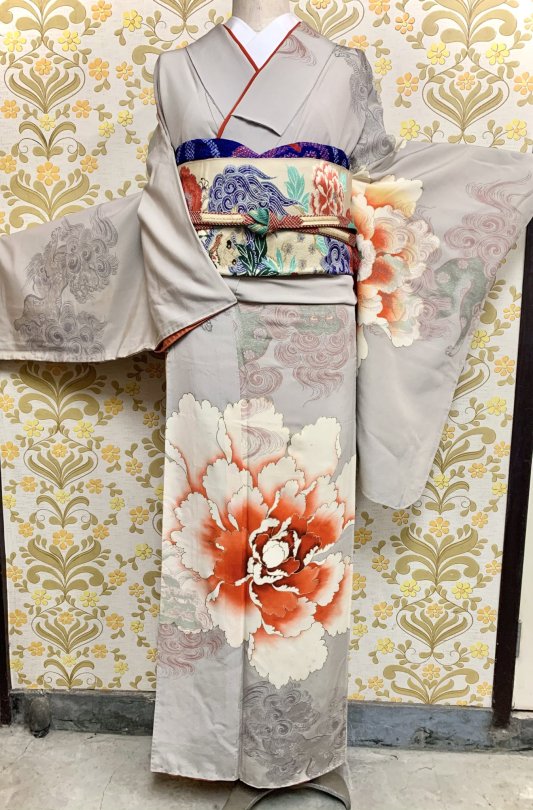
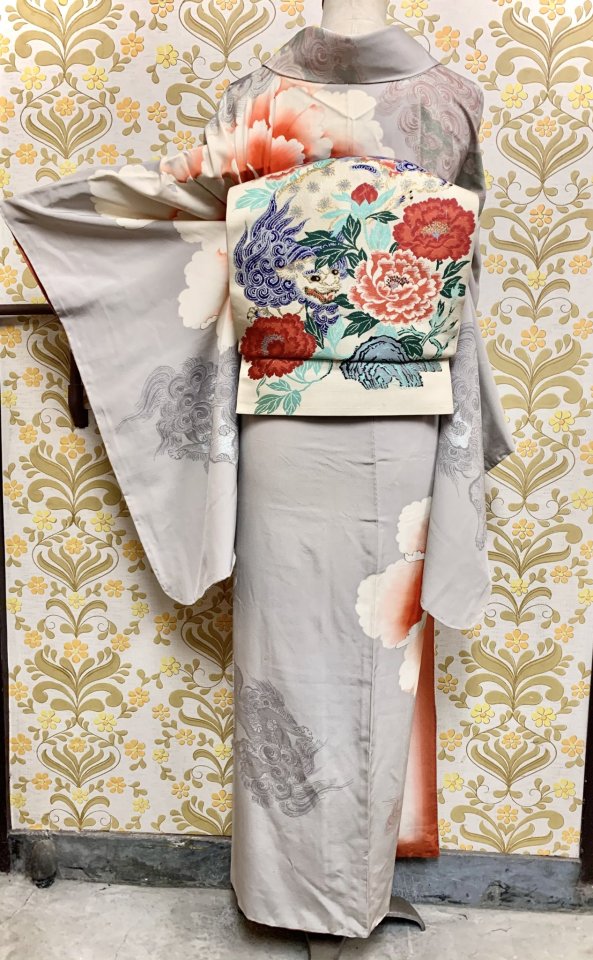
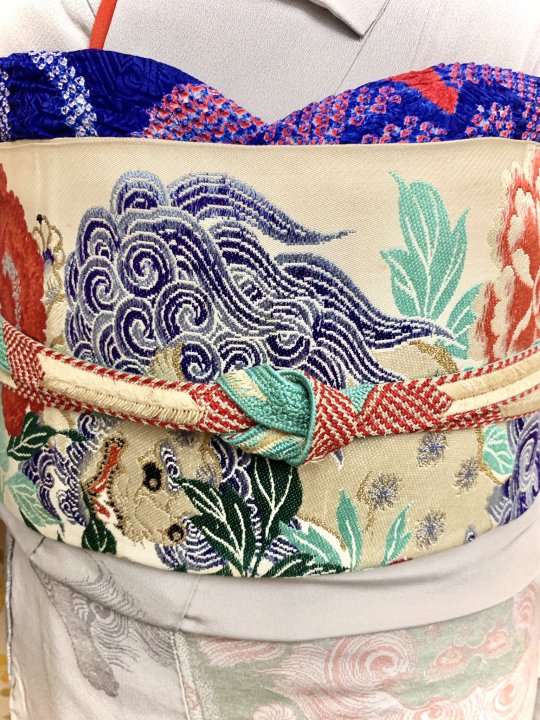

Matching antique kimono and obi, depicting shishi (lions) frolicking among luscious botan (peonies). This pattern association hints at noh play Shakkyo (the stone brigde).
This pattern association might be my all time favourite, I just find it so powerful!
166 notes
·
View notes
Photo
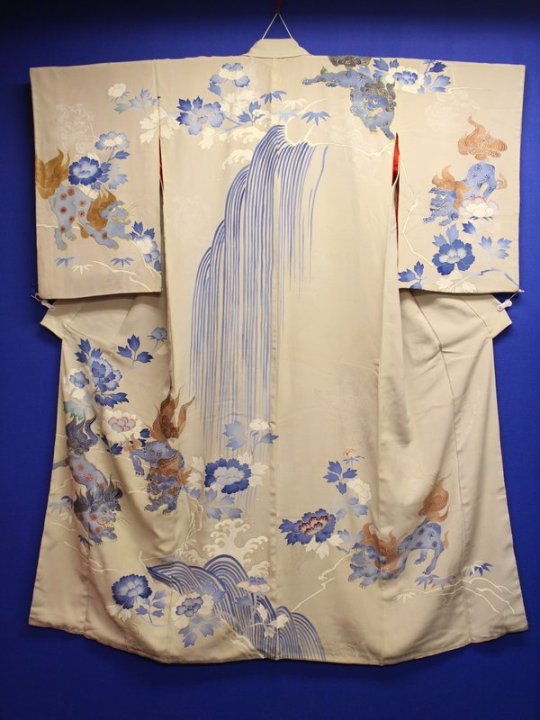



Antique kimono depicting shishi lions frolicking among botan/peony by a dramatic waterfall (seen on)
Those motifs are among my favourites. Shishi are considered king among animals and botan queen among flowers. But most of all those two reminds me of the beautiful “Shakkyo” noh play and the “Kagami Jishi” kabuki play famous for its dynamic lion dance:

[picture from]
(Kagamijishi is on youtube with english commentary - but quality isn’t great :S)
#japan#fashion#kimono#shishi#shishi lion#botan#peony#waterfall#taki#noh#shakkyo#kagami jishi#kabuki#lion dance#着物
337 notes
·
View notes
Photo




Breathtaking Oiran’s lavish uchikake coats (seen on)
Op doesn’t stress if those were actually worn by Oiran or used in Kabuki plays by onnagata in Oiran roles, but I love the shakkyo inspired one (lion guarding paradise bridge), and the hagoromo (heaven maiden’s feather robe)
281 notes
·
View notes
Photo
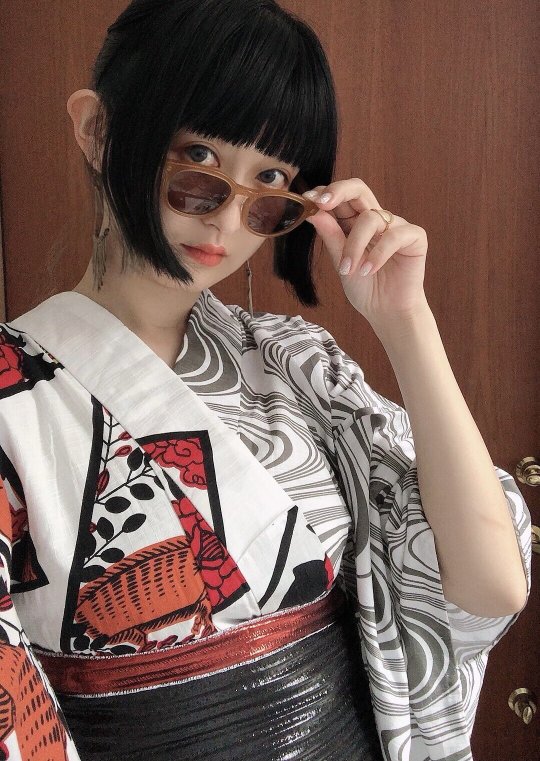
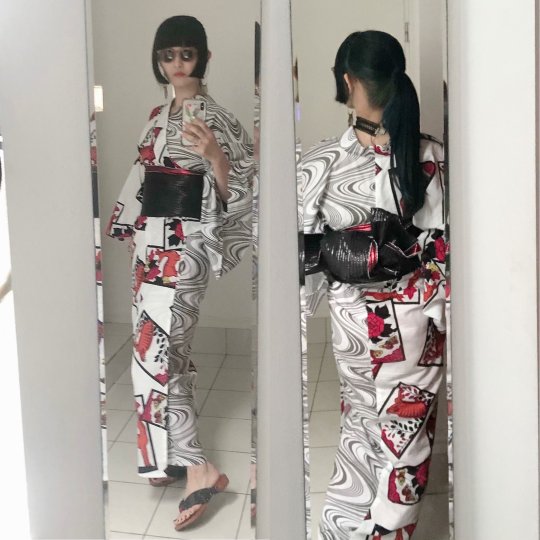
Super cool hanafuda (”flower cards”) + ryuusui (stream) yukata (seen on), paired with a Rumirock obi.
I believe I’ve never touched Hanafuda cards here, so buckle up for a long post ;)

Hanafuda is a card game with 12 different suits of 4 cards. Each suit is linked to a lunar month through symbols, all inspired by classical culture (months where later matched to Western calendar hence why some symbols seem off).
Please note that in the list below, I’ll use ‘meaning’ in the broad sense as following symbols often have many overlaping significations:
睦月 Mutsuki (1st lunar month) / January
=> Symbols: matsu (pine), tsuru (crane), hi (sun), ‘akayoroshi’ tanzaku (paper strip, with auspicious あ(か)よろし meaning lit. ‘red is good’ = ‘really wonderful’)
=> Meaning: eternity, happy/new beginnings as January is the New year month

如月 Kisaragi (2nd lunar month) / February
=> Symbols: ume (plum blossoms), uguisu (bush warbler), ‘akayoroshi’ tanzaku (paper strip, with auspicious あ(か)よろし lit. ‘red is good’ = ‘really wonderful’)
=> Meaning: beginning of spring, well read people (especially refers to Michizane/Tenjin), a match made in heaven
As a side note, plum branches rising to the sky is an auspicious motif known as yariume/“spear plums” or tachibai/“rising plums
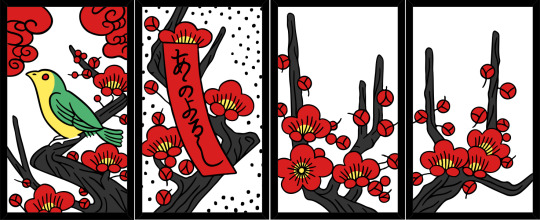
弥生 Yayoi (3rd lunar month) / March
=> Symbols: sakura (cherry blossoms), hanamimaku (curtain, here cherry blossoms viewing parties), ‘Miyoshino” tanzaku (paper strip, Yoshino is a place famous for its sakura)
=> Meaning: beautiful yet fleeting life (like the delicate sakura blossoms)

卯月 Uzuki (4th lunar month) / April
=> Symbols: fuji (wisteria), hototogisu (cuckoo), red tanzaku (paper strip)
=> Meaning: coming of summer, beautiful yet fleeting life (cuckoo sometimes symbolize mourning souls). Fuji could also refers to famous episodes of the Tale of Genji.
As a side note, cuckoo also stands for patience in Japan, probably because of the zen charade known as “If the bird doesn’t sing..”

皐月Satsuki (5th lunar month) / May
=> Symbols: kakitsubata (iris), yatsuhashi (zigzag bridge), red tanzaku (paper strip)
=> Meaning: deep and nostalgic love, inspired by famous poetical scenery from the Tales of Ise (motif is present in many paintings like this screen by Korin). Iris are also a symbol of strenght as seen in Tango no sekku festival
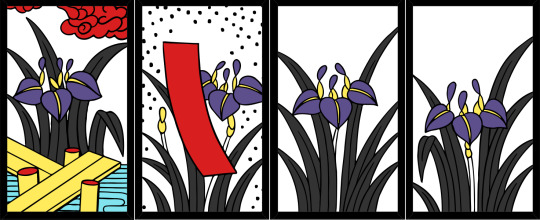
水無月 Minazuki (6th lunar month) / June
=> Symbols: botan (peony), cho (butterfly), purple tanzaku (paper strip)
=> Meaning: road to heaven (symbols came be found in noh piece ‘Shakkyo’ and Kabuki one ‘Kagamijishi’), butterflies often stand as a symbol for spirits or souls

文月 Fumizuki (7th lunar month) / July
=> Symbols: hagi (clover), shishi/inoshishi (boar), red tanzaku (paper strip)
=> Meaning: coming of autumn, the strong needing the meek (a variation of tiger in the bamboo grove motif)

葉月 Hazuki (8th lunar month) / August
=> Symbols: susuki (pampa grass), kari (wild geese), full moon (meigestu)
=> Meaning: moon/harvest festival (tsukimi), deep nostalgia as year goes by (nature will soon be asleep as winter will follow autumn)

長月 Nagatsuki (9th lunar month) / September
=> Symbols: kiku (chrysanthemum), sakazuki (sake cup, with kotobuki/‘long life’ kanji), purple tanzaku (paper strip)
=> Meaning: long life, immortality. In ancient japan, it was customary to drink chrysanthmum wine during Chouyou no en festival as a wish for long life (people also used to drink/use as medicine dew collected on mums leaves and flowers). As a side note, objets flowing in a stream (like sake cups) were once used as timer during poetry competitions.

神無月 Kannazuki (10th lunar month) / October
=> Symbols: momiji (maple), shika (deer)
=> Meaning: momijigari (hanami autumn twin) parties and as March card = beautiful yet fleeting life. Shika deers also have deep auspicious connotation as they are messengers of the gods in Shinto
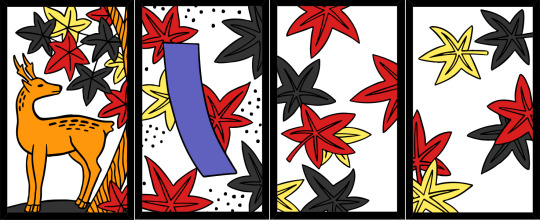
霜月 Shimotsuki (11th lunar month) / November
=> Symbols: yanagi (willow), Ono no Michikaze and a frog, tsubame (swallow), Inazuma (thunder, wildcard sometimes bare and nicknamed “onifuda”/demon card)
=> Meaning: this card is always the most puzzling one for me, as in kimono fashion yanagi+tsubame are not truly a November motifs ^^;
But here, the most important symbol (most often only present as an umbrella!) is a driving rain under which willows dance. Poet Ono no Michikaze, walking by a riverside in that awful weather, spots a struggling frog. After many efforts, the frog finally succeeds jumping in a willow - inspiring Michikaze. This suits hence symbolizes diligence and determination.
As a side note, nure tsubame (lit. “wet sparrows”) symbolize lovers - especially star-crossed ones

師走 Shiwasu (12th lunar month) / December
=> Symbols: kiri (paulownia), houou (phoenix)
=> Meaning: longevity, life circle (“beginning to the end”), power. Legends say phoenix can only nest in paulownia trees

I won’t go into details as to how to play with hanafuda as 1) I am terrible with cards games, and 2) I learned koi-koi rules only thanks to the Ryu ga gotoku/Yakuza video games xD (amazing game serie, if you don’t know about them, go play!!! They have been re-released not long ago)
#japan#fashion#kimono#yukata#hanafuda#card game#cards#lunar month#matsu#tsuru#akayoroshi#tanzaku#uguisu#ume#yariume#tachibai#maku#hanamimaku#Yoshino#sakura#fuji#hototogisu#kakitsubata#ayame#Korin#botan#cho#Shakkyo#Kagamijishi#hagi
596 notes
·
View notes
Photo
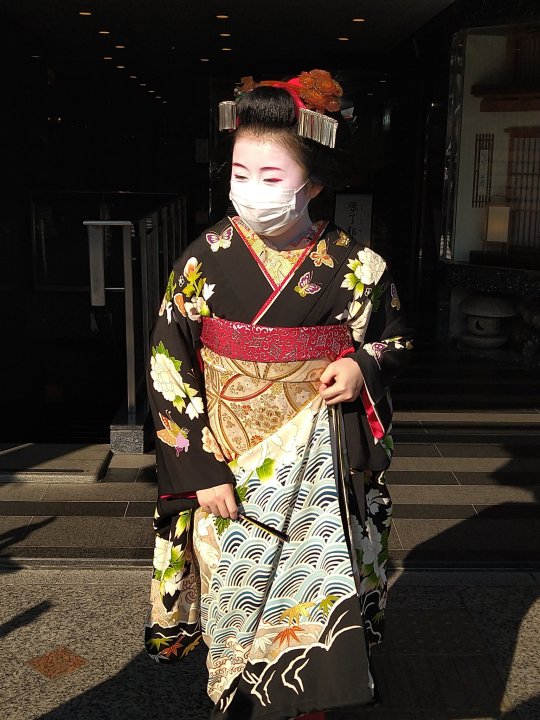

November 15th, 2021: A new maiko is born! Erika (恵利佳) has had her misedashi from the Tsurui (つる居) okiya in Gion Kobu! She is the imōto of natori geiko Sayaka (紗矢佳) and is the 7th debut from Gion Kobu this fall. Her kimono features the Shakkyo (石橋 - Stone Bridge) story with beautiful waves, peonies, and butterflies and her obi features a repeating shippō pattern.
おめでとうさんどす恵利佳ちゃん ^o^!
Images are courtesy of JP Kanrikan.
#maiko#geiko#geisha#kyoto#news#misedashi#debut#gion kobu#tsurui#erika#舞妓#芸妓#芸者#京都#ニューズ#見世出し#店出し#デビュー#祇園甲部#つる居#恵利佳
47 notes
·
View notes
Note
Are Peonies and waterfalls part of a tale or any other reason why they're usually together as kimono motif? Fukusuzu's erikae kimono. <3 Sighs. *.*
Yes, peonies and waterfalls are part of a story called Shakkyo (石橋) meaning "Stone Bridge" that tells the tale of two lions ^^
14 notes
·
View notes
Text
The Kamogawa Odori 2019 - Complete
The kenban has seen fit to upload the deban again this year, which is wonderful for karyukai fans!
The Kamogawa Odori runs from May 1st to 24th at the Pontocho Kaburenjo.
Participants
Geiko: Hisafumi (久富美), Ichisono (市園), Ichimitsu (市光), Ichiwaka (市若), Mamechika (豆千佳), Ichiyoshi (市㐂), Ichichō (市兆), Momino (もみ乃), Momichō (もみ蝶), Ichiho (市穂), Ichikiku (市菊), Hisakayo (久加代), Ichisayo (市さよ), Aya (亜弥), Tomoka (朋佳), Ichimame (市真芽), Hisachō (久蝶), Ichiemi (市笑), Ichiraku (市楽), Momiyuki (もみ幸), Mitsuna (光菜), Ayano (あや野), Ichifuku (市福), Ichino (市乃), Chizu (千鶴), Momifuku (もみ福), Hisasuzu (久鈴), Hisamomo (久桃), Taka (多香), Ichiaya (市彩), and Hidechisa (秀知紗).
Jikata Geiko: Miyosaku (ミヨ作), Mamechiyo (豆千代), Hisaroku (久ろく), Kazumi (かず美), Ichimitsu (市光), Ichiwaka (市若), Mamechika (豆千佳), Ichiyoshi (市㐂), Ichichō (市兆), Momino (もみ乃), Momichō (もみ蝶), Ichiho (市穂), Ichikiku (市菊), Hisakayo (久加代), Ichisayo (市さよ), Aya (亜弥), Tomoka (朋佳), Ichimame (市真芽), Hisachō (久蝶), Ichiemi (市笑), Ichiraku (市楽), Momiyuki (もみ幸), Mitsuna (光菜), Ayano (あや野), Ichifuku (市福), Ichino (市乃), Chizu (千鶴), Momifuku (もみ福), Hisasuzu (久鈴), Hizuru (ひづる), Hisamomo (久桃), Taka (多香), Ichiaya (市彩), and Hidechisa (秀知紗).
Maiko: Ichiyū (市結), Mitsuhana (光はな), Momika (もみ香), Ichisato (市沙登), Ichisumi (市すみ), Ichiai (市愛), Hidekano (秀華乃), Hidemai (秀眞衣), and Hideharu (秀晴).
Tea Ceremony Schedule
May 1st: Tomoka (朋佳) and Momika (もみ香)
May 2nd: Hizuru (ひづる) and Hideharu (秀晴)
May 3rd: Ichino (市乃) and Hidekano (秀華乃)
May 4th: Ichimame (市真芽) and Ichiai (市愛)
May 5th: Momiyuki (もみ幸) and Ichisato (市沙登)
May 6th: Ichiemi (市笑) and Ichisumi (市すみ)
May 7th: Ayano (あや野) and Hidemai (秀眞衣)
May 8th: Momifuku (もみ福) and Hideharu (秀晴)
May 9th: Ichiraku (市楽) and Hidekano (秀華乃)
May 10th: Taka (多香) and Momika (もみ香)
May 11th: Hisasuzu (久鈴) and Ichiyū (市結)
May 12th: Mitsuna (光菜) and Mitsuhana (光はな)
May 13th: Hisamomo (久桃) and Hidemai (秀眞衣)
May 14th: Ichiaya (市彩) and Ichisato (市沙登)
May 15th: Ichifuku (市福) and Ichisumi (市すみ)
May 16th: Taka (多香) and Ichiai (市愛)
May 17th: Hidechisa (秀知紗) and Hideharu (秀晴)
May 18th: Chizu (千鶴) and Mitsuhana (光はな)
May 19th: Hisamomo (久桃) and Hidemai (秀眞衣)
May 20th: Hisachō (久蝶) and Ichiyū (市結)
May 21st: Ichisayo (市さよ) and Hidekano (秀華乃)
May 22nd: Ayano (あや野) and Ichiai (市愛)
May 23rd: Hidechisa (秀知紗) and Ichisato (市沙登)
May 24th: Chizu (千鶴) and Ichisumi (市すみ)
Part 1: Waka Yo Tare So ~ Tsutsui Zutsu ~ Gojō (わかよたれそ~筒井筒~五場) - Who In Our World? Around The Round Well’s Frame in Five Locations
Group 1: May 1st, 4th, 7th, 10th, 13th, 16th, 19th, and 22nd
Michimaru (道丸): Hisakayo (久加代)
Aki Hime (明姫): Ichisayo (市さよ)
Young Michimaru (幼少期の道丸): Mitsuna (光菜)
Young Aki Hime (幼少期明姫): Chizu (千鶴)
Hikaru Genji (光源氏): Ichiraku (市楽)
Arihara Narihira (在原業平): Momiyuki (もみ幸)
Third Son (三郎): Aya (亜弥)
Lady’s Attendant #1 (侍女1): Ichiaya (市彩)
Lady’s Attendant #2 (侍女2): Hidechisa (秀知紗)
Group 2: May 2nd, 5th, 8th, 11th, 14th, 17th, 20th, and 23rd
Michimaru (道丸): Momino (もみ乃)
Aki Hime (明姫): Momichō (もみ蝶)
Young Michimaru (幼少期の道丸): Ichifuku (市福)
Young Aki Hime (幼少期明姫): Tomoka (朋佳)
Hikaru Genji (光源氏): Ichiemi (市笑)
Arihara Narihira (在原業平): Ichino (市乃)
Third Son (三郎): Ichichō (市兆)
Lady’s Attendant #1 (侍女1): Hisamomo (久桃)
Lady’s Attendant #2 (侍女2): Taka (多香)
Group 3: May 3rd, 6th, 9th, 12th, 15th, 18th, 21st, and 24th
Michimaru (道丸): Ichiho (市穂)
Aki Hime (明姫): Ichikiku (市菊)
Young Michimaru (幼少期の道丸): Momifuku (もみ福)
Young Aki Hime (幼少期明姫): Ichimame (市真芽)
Hikaru Genji (光源氏): Hisachō (久蝶)
Arihara Narihira (在原業平): Ayano (あや野)
Third Son (三郎): Ichiyoshi (市㐂)
Lady’s Attendant #1 (侍女1): Hisasuzu (久鈴)
Lady’s Attendant #2 (侍女2): Ichiaya (市彩)
Enso Rokuon (演奏録音) - Musical Accompaniment
Singers (唄): Hisaroku (久ろく), Mamechika (豆千佳), and Momino (もみ乃)
Shamisen (三味線): Mamechiyo (豆千代), Kazumi (かず美), and Momichō (もみ蝶)
Fue (笛): Tousha Meishō (藤舎名生)
Koto (箏): Nakagawa Toshihiro (中川敏裕)
Kabuki Accompanists (鳴物): Tousha Kiyotaka (藤舎清鷹), Tousha Etsuyoshi (藤舎悦芳), Nakamura Kotozuru (中村壽鶴), and Mochizuki Kiyosaburo (望月清三郎)
Part 2: Adesugata Shinmiyo Matsuri Shichikei (艶姿祝新御代祭七景) - Festival of Alluring Figures To Celebrate The New Era in Seven Scenes
Scene 1: Shinmiyo Matsuri (新御代祭) - Festival To Celebrate The New Era
Group 1: May 1st, 4th, 7th, 10th, 13th, 16th, 19th, and 22nd
Fire Fighter #1 (鳶頭1): Hisakayo (久加代)
Fire Fighter #2 (鳶頭2): Ichiraku (市楽)
Traditional Dancers (手古舞): Mitsuna (光菜), Chizu (千鶴), and Ichiaya (市彩)
Geiko (芸妓): Aya (亜弥) and Momiyuki (もみ幸)
Maiko (舞妓): Ichiyū (市結), Mitsuhana (光はな), Ichisato (市沙登), Ichisumi (市すみ), Hidekano (秀華乃), and Hideharu (秀晴)
Group 2: May 2nd, 5th, 8th, 11th, 14th, 17th, 20th, and 23rd
Fire Fighter #1 (鳶頭1): Momino (もみ乃)
Fire Fighter #2 (鳶頭2): Ichiemi (市笑)
Traditional Dancers (手古舞): Ichifuku (市福), Hisamomo (久桃), and Taka (多香)
Geiko (芸妓): Tomoka (朋佳) and Ichino (市乃)
Maiko (舞妓): Mitsuhana (光はな), Momika (もみ香), Ichisumi (市すみ), Ichiai (市愛), Hidekano (秀華乃), and Hidemai (秀眞衣)
Group 3: May 3rd, 6th, 9th, 12th, 15th, 18th, 21st, and 24th
Fire Fighter #1 (鳶頭1): Ichiho (市穂)
Fire Fighter #2 (鳶頭2): Hisachō (久蝶)
Traditional Dancers (手古舞): Momifuku (もみ福), Hisasuzu (久鈴), and Ichiaya (市彩)
Geiko (芸妓): Ichimame (市真芽) and Ayano (あや野)
Maiko (舞妓): Ichiyū (市結), Momika (もみ香), Ichisato (市沙登), Ichiai (市愛), Hidemai (秀眞衣), and Hideharu (秀晴)
Scene 2: Shakkyo (石橋) - Stone Bridge
Group 1: May 1st, 4th, 7th, 10th, 13th, 16th, 19th, and 22nd
Geiko (芸妓): Aya (亜弥) and Momiyuki (もみ幸)
Group 2: May 2nd, 5th, 8th, 11th, 14th, 17th, 20th, and 23rd
Geiko (芸妓): Tomoka (朋佳) and Ichino (市乃)
Group 3: May 3rd, 6th, 9th, 12th, 15th, 18th, 21st, and 24th
Geiko (芸妓): Ichimame (市真芽) and Ayano (あや野)
Scene 3: Daimonji (大文字)
Group 1: May 1st, 4th, 7th, 10th, 13th, 16th, 19th, and 22nd
Geiko (芸妓): Ichisayo (市さよ), Mitsuna (光菜), and Chizu (千鶴)
Group 2: May 2nd, 5th, 8th, 11th, 14th, 17th, 20th, and 23rd
Geiko (芸妓): Ichichō (市兆), Ichifuku (市福), and Hisamomo (久桃)
Group 3: May 3rd, 6th, 9th, 12th, 15th, 18th, 21st, and 24th
Geiko (芸妓): Ichiyoshi (市㐂), Momifuku (もみ福), and Hisasuzu (久鈴)
Scene 4: Ikkyū (一休)
Group 1: May 1st, 4th, 7th, 10th, 13th, 16th, 19th, and 22nd
Ikkyū (一休): Hisafumi (久富美)
Maiko (舞妓): Ichiyū (市結), Mitsuhana (光はな), Ichisato (市沙登), and Ichisumi (市すみ)
Hell Tayū (地獄太夫): Hisakayo (久加代)
Group 2: May 2nd, 5th, 8th, 11th, 14th, 17th, 20th, and 23rd
Ikkyū (一休): Momino (もみ乃)
Maiko (舞妓): Mitsuhana (光はな), Momika (もみ香), Ichisumi (市すみ), and Ichiai (市愛)
Hell Tayū (地獄太夫): Momichō (もみ蝶)
Group 3: May 3rd, 6th, 9th, 12th, 15th, 18th, 21st, and 24th
Ikkyū (一休): Mamechika (豆千佳)
Maiko (舞妓): Ichiyū (市結), Momika (もみ香), Ichisato (市沙登), and Ichiai (市愛)
Hell Tayū (地獄太夫): Ichikiku (市菊)
Scene 5: Hanjo (班女)
Group 1: May 1st, 4th, 7th, 10th, 13th, 16th, 19th, and 22nd
Hanjo (班女): Ichisono (市園)
Group 2: May 2nd, 5th, 8th, 11th, 14th, 17th, 20th, and 23rd
Hanjo (班女): Ichiwaka (市若)
Group 3: May 3rd, 6th, 9th, 12th, 15th, 18th, 21st, and 24th
Hanjo (班女): Ichimitsu (市光)
Scene 6: Haja No Tsurugi (破邪の剱) - The Sword That Crushes Evil
Group 1: May 1st, 4th, 7th, 10th, 13th, 16th, 19th, and 22nd
Dancers (舞): Ichisayo (市さよ), Ichiraku (市楽), Aya (亜弥), Momiyuki (もみ幸), Mitsuna (光菜), Chizu (千鶴), and Ichiaya (市彩)
Group 2: May 2nd, 5th, 8th, 11th, 14th, 17th, 20th, and 23rd
Dancers (舞): Momichō (もみ蝶), Ichiemi (市笑), Tomoka (朋佳), Ichifuku (市福), Ichino (市乃), Hisamomo (久桃), and Taka (多香)
Group 3: May 3rd, 6th, 9th, 12th, 15th, 18th, 21st, and 24th
Dancers (舞): Ichiho (市穂), Ichikiku (市菊), Hisachō (久蝶), Ichimame (市真芽), Ayano (あや野), Momifuku (もみ福), and Hisasuzu (久鈴)
Scene 7: Finale (フィナーレ)
Group 1: May 1st, 4th, 7th, 10th, 13th, 16th, 19th, and 22nd
Dancers (舞): Hisakayo (久加代), Ichiraku (市楽), Mitsuna (光菜), Chizu (千鶴), Ichiaya (市彩), Aya (亜弥), Momiyuki (もみ幸), Ichiyū (市結), Mitsuhana (光はな), Ichisato (市沙登), Ichisumi (市すみ), Hidekano (秀華乃), Hideharu (秀晴), Ichisayo (市さよ), Hisafumi (久富美), Ichisono (市園), and Hidechisa (秀知紗)
Group 2: May 2nd, 5th, 8th, 11th, 14th, 17th, 20th, and 23rd
Dancers (舞): Momino (もみ乃), Ichiemi (市笑), Ichifuku (市福), Hisamomo (久桃), Taka (多香), Tomoka (朋佳), Ichino (市乃), Mitsuhana (光はな), Momika (もみ香), Ichisumi (市すみ), Ichiai (市愛), Hidekano (秀華乃), Hidemai (秀眞衣), Ichichō (市兆), Momichō (もみ蝶), and Ichiwaka (市若)
Group 3: May 3rd, 6th, 9th, 12th, 15th, 18th, 21st, and 24th
Dancers (舞): Ichiho (市穂), Hisachō (久蝶), Momifuku (もみ福), Hisasuzu (久鈴), Ichiaya (市彩), Ichimame (市真芽), Ayano (あや野), Ichiyū (市結), Momika (もみ香), Ichisato (市沙登), Ichiai (市愛), Hidemai (秀眞衣), Hideharu (秀晴), Ichiyoshi (市㐂), Mamechika (豆千佳), Ichikiku (市菊), and Ichimitsu (市光)
Jikata Performers
Group 1: May 1st, 4th, 7th, 10th, 13th, 16th, 19th, and 22nd
Singers (唄): Hisaroku (久ろく), Ichiho (市穂), Hisasuzu (久鈴), Mamechika (豆千佳), Momino (もみ乃), and Ichimame (市真芽). Mamechika, Momino, and Ichimame will swap out every other shift.
Shamisen (三味線): Mamechiyo (豆千代), Ichikiku (市菊), Ichino (市乃), and Hizuru (ひづる)
Fue (笛): Momifuku (もみ福)
Kotsuzumi (小鼓): Ichiwaka (市若) and Ichifuku (市福)
Otsuzumi (大鼓): Hisachō (久蝶)
Taiko (太鼓): Ichiemi (市笑)
Group 2: May 2nd, 5th, 8th, 11th, 14th, 17th, 20th, and 23rd
Singers (唄): Mamechika (豆千佳), Ichimame (市真芽), Momiyuki (もみ幸), Hisasuzu (久鈴), Ichiho (市穂), and Miyosaku (ミヨ作). Momiyuki, Hisasuzu, and Ichiho will swap out every other shift.
Shamisen (三味線): Kazumi (かず美), Mamechiyo (豆千代), Ichisayo (市さよ), and Chizu (千鶴)
Fue (笛): Ayano (あや野)
Kotsuzumi (小鼓): Ichiyoshi (市㐂) and Mitsuna (光菜)
Otsuzumi (大鼓): Ichiraku (市楽)
Taiko (太鼓): Ichimitsu (市光)
Group 3: May 3rd, 6th, 9th, 12th, 15th, 18th, 21st, and 24th
Singers (唄): Momino (もみ乃), Hisaroku (久ろく), Momiyuki (もみ幸), and Hidechisa (秀知紗)
Shamisen (三味線): Momichō (もみ蝶), Kazumi (かず美), Hisakayo (久加代), and Hizuru (ひづる)
Fue (笛): Aya (亜弥)
Kotsuzumi (小鼓): Tomoka (朋佳) and Hisamomo (久桃)
Otsuzumi (大鼓): Taka (多香)
Taiko (太鼓): Ichichō (市兆)
Notes On Scenes
Part 1: Waka Yo Tare So ~ Tsutsui Zutsu ~ Gojo (わかよたれそ~筒井筒~五場) - Who In Our World? Around The Round Well’s Frame in Five Locations
This one is purely based on speculation, but it appears as though this scene will have something to do with characters who fall through a well into a different world, kinda like with what happened in Inu Yasha. The title of the scene itself comes from The Song of Iroha, which is one of the oldest Buddhist poems in Japan and is a source of national pride.
Enso Rokuon (演奏録音) - Musical Accompaniment
These are the people who will be performing the jikata during Part 1. Once the dance is over they will continue to perform for a few minutes to allow for scene changes.
Part 2: Adesugata Shinmiyo Matsuri Shichikei (艶姿祝新御代祭七景) - Festival of Alluring Figures To Celebrate The New Era in Seven Scenes
The second half of the odori is always comprised of a number of smaller scenes, usually six or seven, with their own individual stories and participants. It’s not unusual to have two scenes that contain the same dancers back to back; this is done so that others may perform costume changes.
Scene 1: Shinmiyo Matsuri (新御代祭) - Festival To Celebrate The New Era
This scene hearkens back to the Edo Period and to the acrobatics of fire fighters. Since the fire fighters needed to be able to climb ladders and such quickly these techniques soon developed into their own style of performance that they would show off to the public during festivals and compete against other fire fighting squads, akin to an acrobatics or dance competition!
Scene 2: Shakkyo (石橋) - Stone Bridge
Continuing the festival theme, this dance tells the tale of two lions who chase butterflies along a stone bridge. It doesn’t appear as though the performers will be dressed as lions, but will rather be performing this piece as they usually would.
Scene 3: Daimonji (大文字)
Just from looking at the title it seems as though this will be a dance that focuses on the famous bonfires that are lit on the side of the Daimonji mountain in the summer.
Scene 4: Ikkyū (一休)
Ikkyū was a monk and poet during the Edo Period who was said to have many fantastical adventures. From the titles of the characters involved it looks like it will be quite an interesting act!
Scene 5: Hanjo (班女)
Hanjo is a Noh play by Zeami, one of the founders of Noh Theatre. This scene will likely be a short version of that play.
Scene 6: Haja No Tsurugi (破邪の剱) - The Sword That Crushes Evil
To be honest I have no idea what this scene is about, but just from the title it sounds pretty awesome! This title can also be translated as “The Curse Breaking Sword.”
Scene 7: Finale (フィナーレ)
The final scene each year. All participants who performed on stage that day come together for one final dance among the wisteria decorations.
34 notes
·
View notes